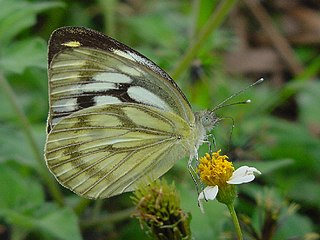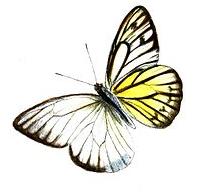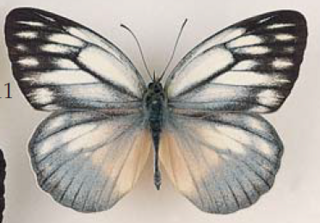
Hadrocodium wui is an extinct mammaliaform that lived during the Sinemurian stage of the Early Jurassic approximately 195 million years ago in the Lufeng Formation in what is now the Yunnan province in south-western China (25.2°N 102.1°E, paleocoordinates 34.3°N 104.9°E). It is considered as the closest relative of the class Mammalia.

Cepora nerissa, the common gull, is a small to medium-sized butterfly of the family Pieridae, that is, the yellows and whites, which is native to Sri Lanka, India, China, southeast Asia, and Indonesia.

Cepora is a genus of butterflies, commonly called gulls, in the family Pieridae. The genus contains about 20 species shared between the Indomalayan and Australasian realms.

Cepora pactolicus is a butterfly in the family Pieridae. It is found on Borneo.

Cepora boisduvaliana is a butterfly in the family Pieridae. It is found on the Philippines.

Cepora aspasia is a butterfly in the family Pieridae, found in Indonesia.

Cepora celebensis is a butterfly in the family Pieridae. It is found on Sulawesi.
Cepora julia is a butterfly in the family Pieridae. It is found on Sumba and Sumbawa.

Cepora timnatha is a butterfly in the family Pieridae. It is found in Indonesia.
Cepora temena is a butterfly in the family Pieridae. It is found in Indonesia.

Cepora abnormis, the Papuan gull, is a species of butterfly in the family Pieridae found in Indonesia.

Cepora eperia, the Sulawesi gull, is a butterfly in the family Pieridae. It is found on Sulawesi.
Cepora licea is a butterfly in the family Pieridae. It is found on Nias.
Cepora laeta, the Timor gull, is a butterfly in the family Pieridae. It is found on Timor.
Cepora eurygonia is a butterfly in the family Pieridae. It is found on north-eastern Sulawesi.

Cepora fora is a butterfly in the family Pieridae. It is found on Sulawesi.
Cepora kotakii is a butterfly in the family Pieridae. It is found on Simeulue Island.

Xiangshuiosteus wui is an extinct monospecific genus of brachythoracid arthrodire placoderm from the Late Emsian stage of the Early Devonian epoch, discovered in Wuding County of Yunnan province, China. It has recently been reassessed as a dunkleosteid.









